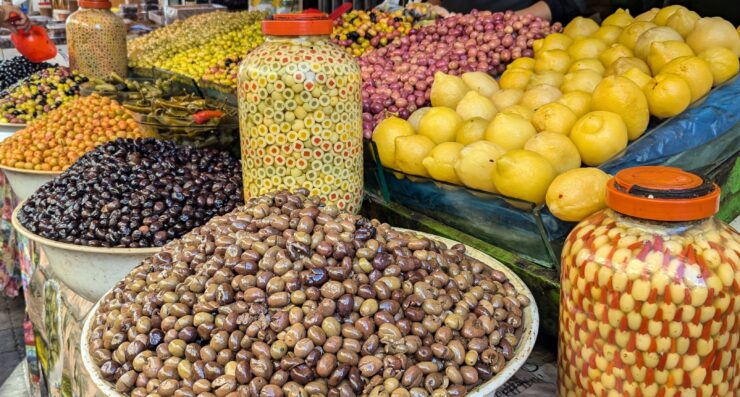The first taste of tagine burst into fireworks in my mouth. Not the big explosive kind that go boom, but the showery type that shatters into a million pinpoints of light, vivid flavors sorting themselves into layers of complexity. The tartness of the preserved lemon, the sweetness of the quince, and the earthy warmth of the turmeric dominated, but ginger and garlic pushed forward, followed by cinnamon notes.
It was the first day of my trip to Morocco with my husband, our second visit in two years, and so far, the food exceeded my high expectations.
I developed a passion for the flavors of Moroccan food during my previous visit. Since I grew up with the intense flavors of Pakistan, Bangladesh, and Indonesia, I recognized the distinct flavors of turmeric, ginger, and cumin. Yet I appreciated the lighter touch used in Moroccan food.
Connecting to Morocco Through Its Food
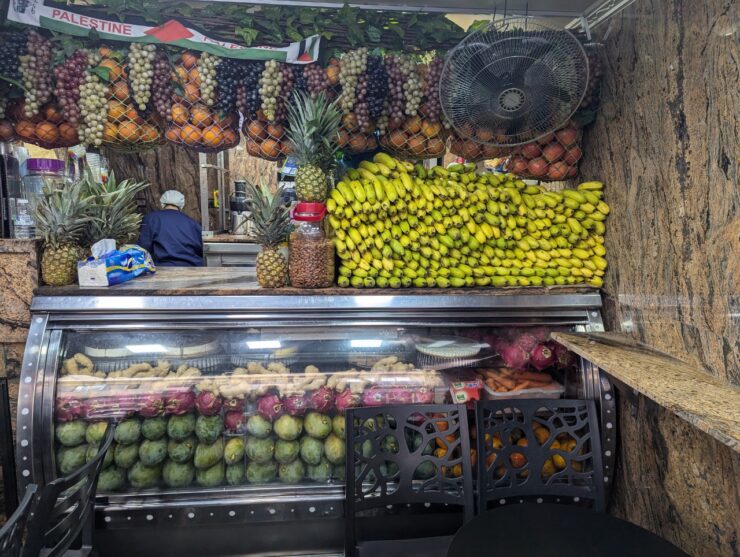
I often connect to a country through its food, and I’ve found that a food tour is a great way to start a trip. It’s a jumpstart for the senses — walking through the markets, seeing the colorful produce, smelling foods cooking on a grill, and tasting little bites. The guides always steer me to foods they recommend, and learning the names of everyday dishes means I’ll know what to order on the rest of my trip.
For my second visit to Morocco, I wanted to learn more about the country. I scheduled a food walking tour in Tangier through Get Your Guide and a cooking class in Marrakech through Cookly.me.
Food Walking Tour, Tangier
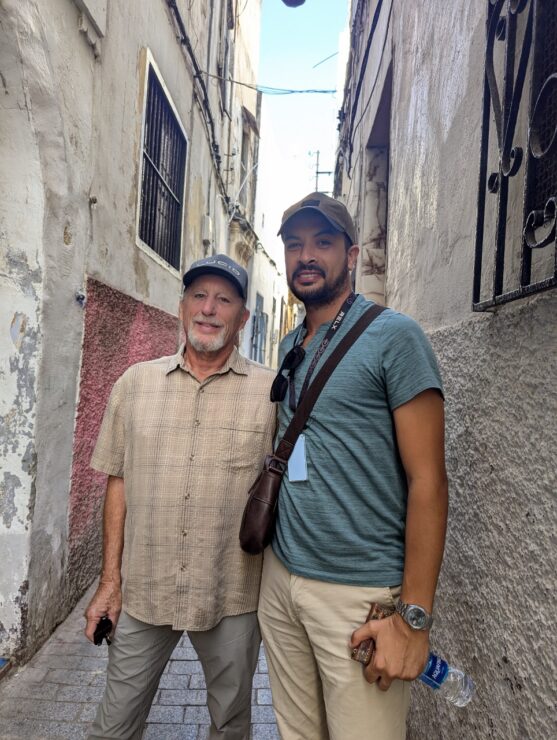
Mohammed Marrakchi, a resident of Tangier, escorted us through the local markets and tiny storefronts in the historic center of the city during the Food Walking Tour in Tangier. He was an excellent guide, sprinkling in tidbits about the city’s history and offering tips on where to visit elsewhere in Morocco. His deep knowledge of his country’s history, excellent English skills, and easygoing personality make him a wonderful guide.
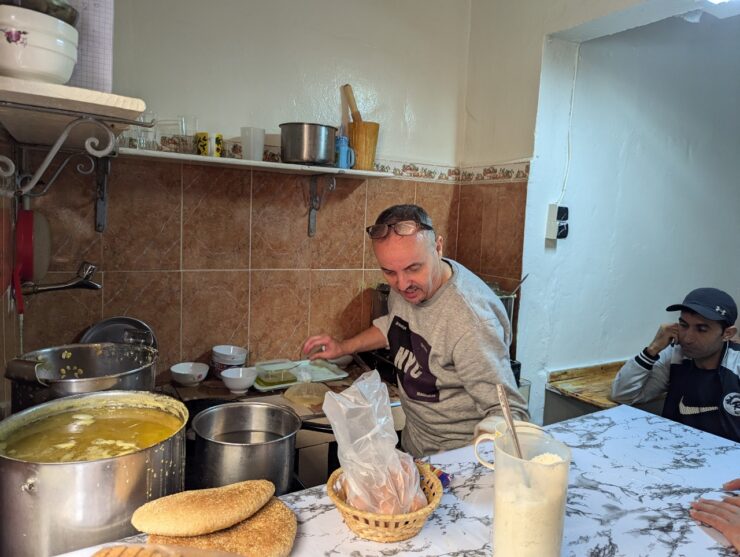
“In this small shop, you will meet Ahmed. I call him the Soup DJ,” said Mohammed with a smile. Ahmed’s creamy bissara soup made from pureed split peas was pure comfort food.
Headed to southern Spain? Tangier is just a ferry ride away. Read about Andalusia, Spain.
As we walked through the market, I accepted a bag of olives from a vendor. I later sampled sweet dates stuffed with crunchy walnuts and cashews. A filling fruit smoothie made from mango and pomegranate worried me because I couldn’t stop drinking it, despite how full I was getting.
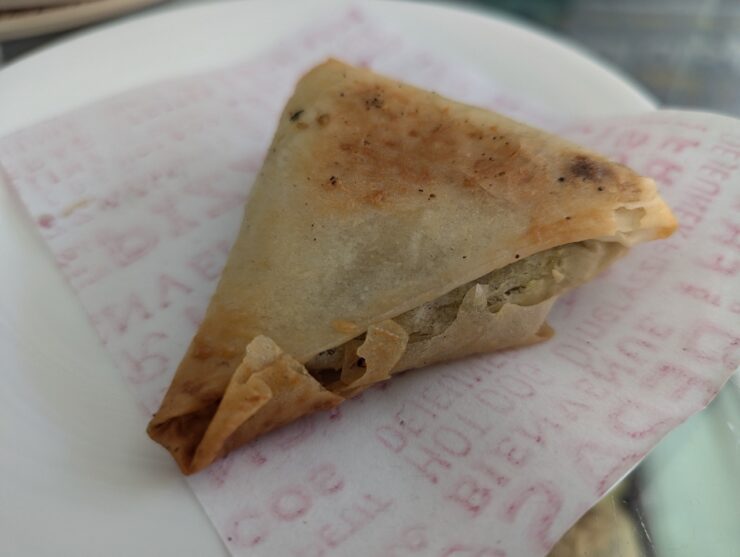
A highlight was briouat, a meltingly flaky pastry filled with savory meat spiced with saffron, cinnamon, and ginger. I thought that was the end of the tour, but the tagine was still to come. Somehow, I had to find more room.
The Tagine of Tangier
Tagine is ubiquitous in Morocco, and even I can tire of it. Tagine refers to both the conical pottery cooking vessel and the stews cooked in it. The cone shape of the lid allows moisture to collect and drip back to the bottom. Historically, people cooked tagine over hot coals or an open flame, though modern cooks use an electric stove top or oven.
Many tourist establishments serve a simple tagine with a base of couscous in a shallow dish, with mildly spiced meat piled in the center. Colorful strips of carrot and squash are laid over the couscous and meat, rising to meet at a point under the lid of a conical tagine cooker, as if it were cooked that way.
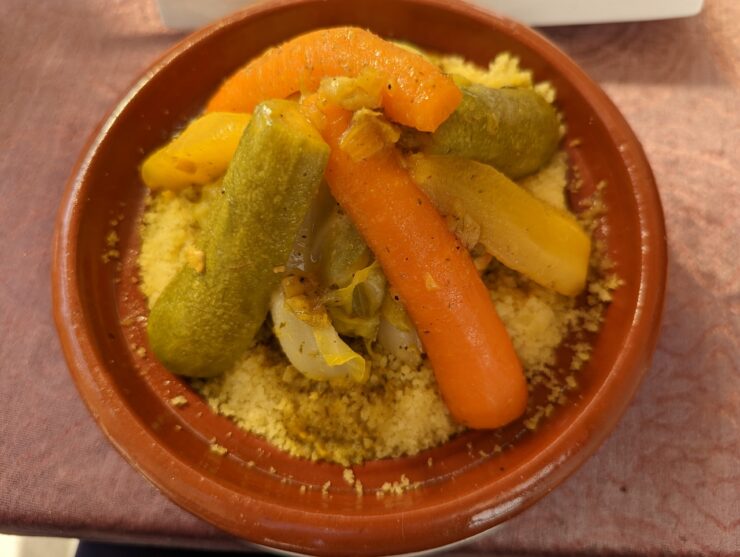
However, couscous is not typically served with tagine in Moroccan households, but rather only for tourists. Couscous is popular in Morocco, but not typically paired with tagine. For tourists, the couscous is steamed separately, piled into the tagine cooker, and topped with meat and vegetables because apparently, we expect it.
Khobz, the Daily Bread of Morocco
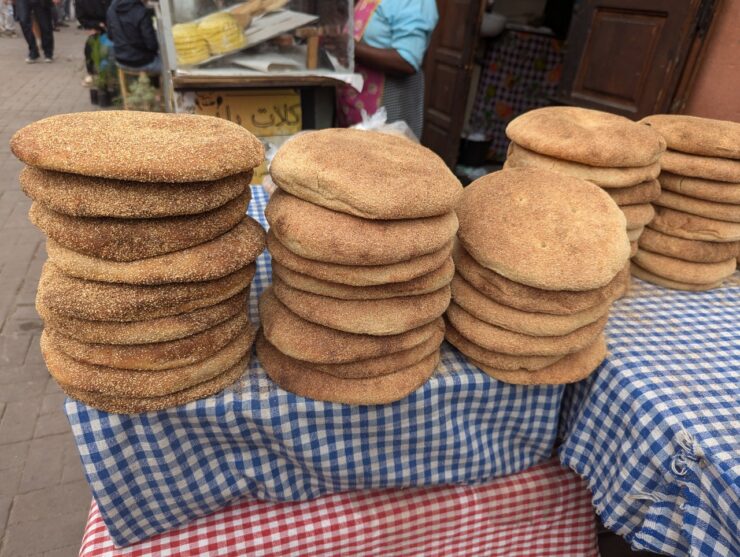
With tagine (and nearly every meal), Moroccans eat yeasty khobz bread, a traditional flatish bread (not as flat as the type we think of for wraps). Khobz may be cooked at home if the house is equipped with an oven, but is often still cooked in communal ovens.
It’s common to see people walking through the narrow streets of the old town medina to the communal oven, conveying a tray covered with a cloth, hiding soft mounds of dough. Mohammed ushered us into a dim communal oven where the morning bread-making had concluded and the baker had moved on to roasting trays of nuts.
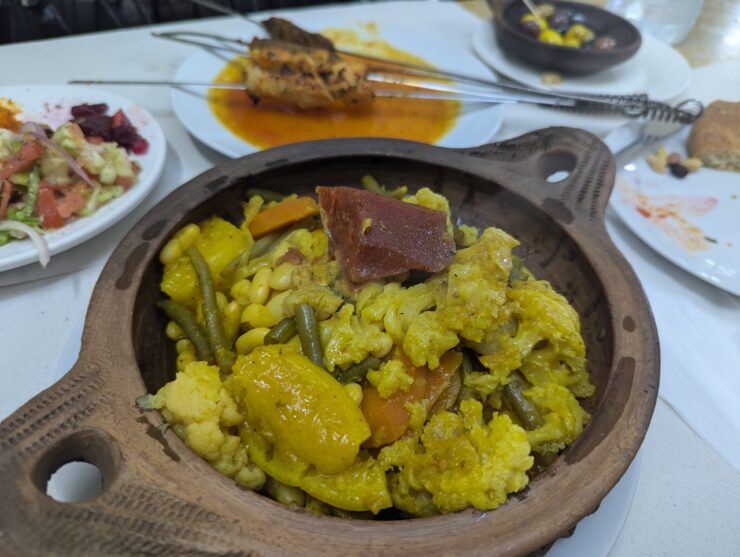
The tagine I sampled at the casual establishment in Tangier on our food tour was exquisite, bursting with flavor. The sounds of Arabic table talk among the men faded as I savored the chicken falling off the bone. White beans, green beans, quince, potatoes, cauliflower, and carrots rounded out this hearty meal. There was no couscous.
Leaving the remains of salad, kebabs, bread, and olives behind, I focused on finishing the tagine. This was by far the best tagine I have ever had.
White Flowers Cooking Class, Marrakech
The White Flowers Cooking Class in Marrakech advertised a different menu for each day of the week. I chose my date with a particular dish in mind, imagining a large class in a professional kitchen with ingredients already prepped.
Instead, we, the only students, were welcomed to the charming White Flowers riad — a traditional house built around an open-air courtyard in the heart of the medina. There we met Zach, our guide and translator, and Fatima, our cooking instructor. To my surprise, the menu was flexible. After some discussion, Fatima and Zach suggested kefta tagine, made with ground meat. Soon we were winding through the medina to the market for fresh beef and vegetables for a second tagine.
As we walked along the narrow streets, Zach pointed out things I hadn’t noticed, such as the high and low door knockers. In the past, the high knocker was for men, while the lower one was for women. This was so that a person on the inside could tell who was knocking.
In the Kitchen
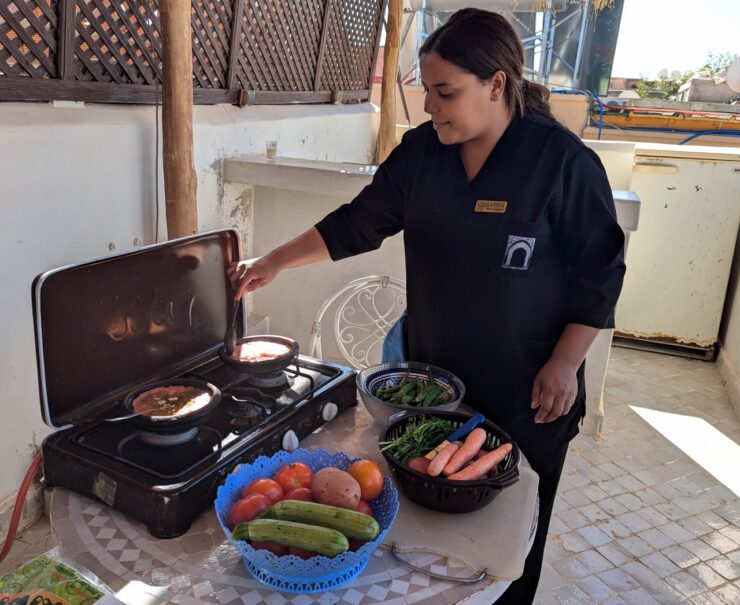
From the informal outdoor kitchen on the roof of the riad where Fatima conducted the class, we had an expansive view across the top of the medina. A thatched roof over the cooking space provided protection from the sun. In the kitchen was a portable two-burner gas stove, like a Coleman stove, along with a round table and a knife. No measuring instruments.
Fatima had pureed the tomatoes, separated the garlic cloves, and washed the vegetables to make things easier for us.
“These are the spices that every Moroccan kitchen has,” said Zach, translating for Fatima, who pointed at five small ceramic dishes with salt, ginger, turmeric, cumin, and black pepper. “Cooks may use more, but this is the minimum. When I was a poor student, I would go to the market and purchase tiny packets of these spices, enough for one meal.”
Making Kefta Tagine
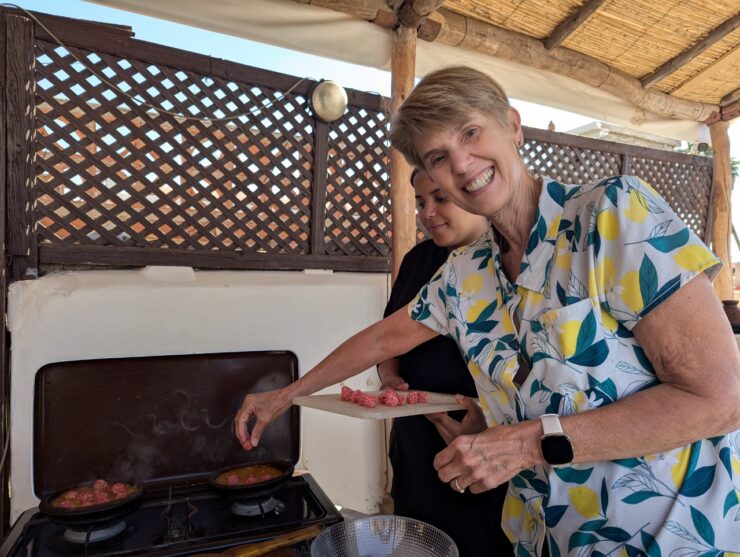
Fatima guided us through the steps to make our kefta tagine.
- Pour oil into the base of the tagine cooker, then add the pureed tomatoes.
- Add pinches of spices and fresh, chopped garlic to the tomatoes and simmer for ten minutes.
- Form small meatballs and add to the tomatoes.
- Place the cone-shaped lid on top and simmer until the meat is cooked.
- Add lots of chopped parsley, even thick stems.
- Add whole or scrambled eggs (optional).
- Serve with bread.
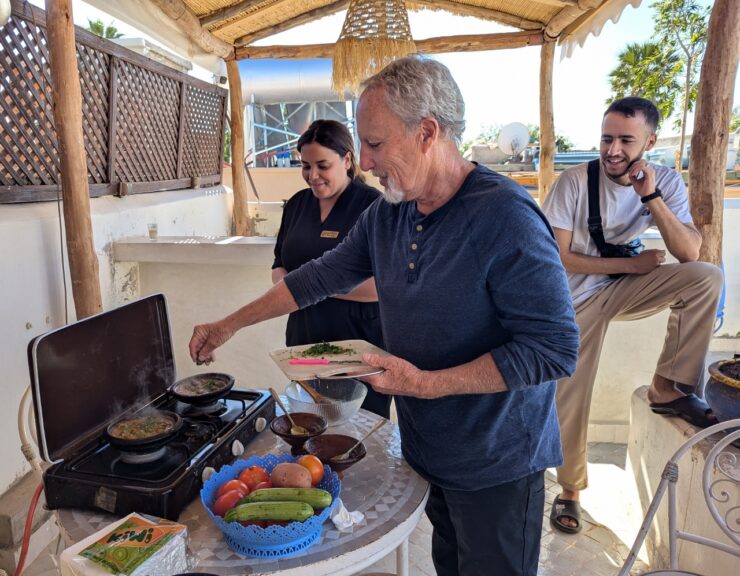
As the tagine bubbled on the stove, we chatted with Zach and Fatima. We learned that Zach had been trapped in Turkey during the pandemic, where he was attending university, missing his family terribly. Despite parental expectations, Fatima wasn’t sure she ever wanted to get married—she was enjoying being an independent woman–working at the riad, teaching cooking, and making her own money.
I was struck by how much they had in common with young people anywhere in the world, having their schooling interrupted by the pandemic and not knowing exactly where life would take them.
Meatballs Like Clouds
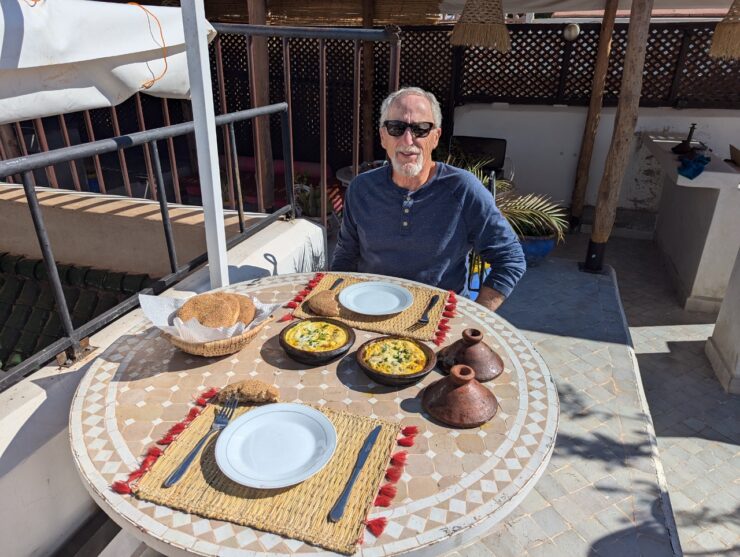
When the tiny meatballs were ready, we were seated at a round table in the bright sunlight, a cool breeze saving us from overheating. The tagine cooker was brought from the stove to the table. The lid was removed with a flourish, and we ate directly from the base. The kefta meatballs were light and tender, like puffs of cloud. The few spices we used in the tomato sauce were perfectly balanced. We didn’t use any spices in the meatballs, but because they were so small, they picked up plenty of seasoning from the sauce. This simple meal came together quickly and was packed with flavor.
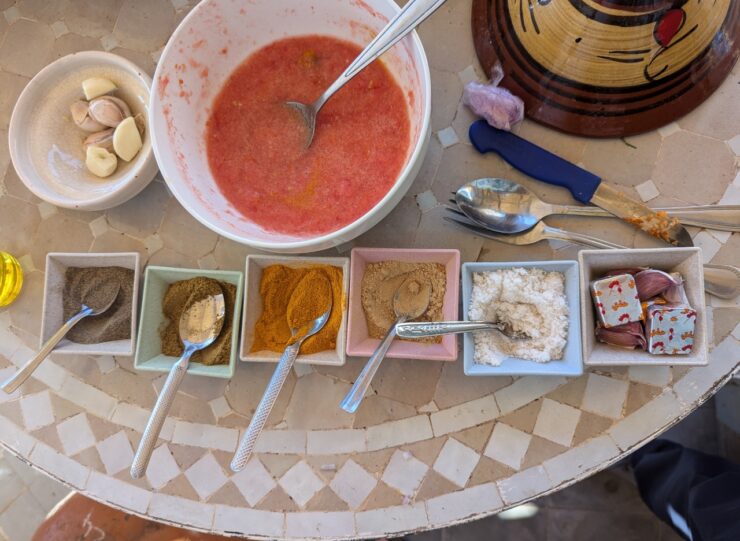
A vegetable tagine followed. Chopped onions, pureed tomatoes, peas, and sliced wedges of potato and zucchini were topped with chopped parsley. The flavors were bright and fresh, with textures that were contrasting yet harmonious. What struck me most was the simplicity — nothing fancy, just market-fresh vegetables and basic techniques — yet the result was unforgettable.
The real feast wasn’t just the food. It was the connection with Zach and Fatima, sharing stories, and tasting a slice of Moroccan life.
Benefits of the Moroccan Food Tour and Class
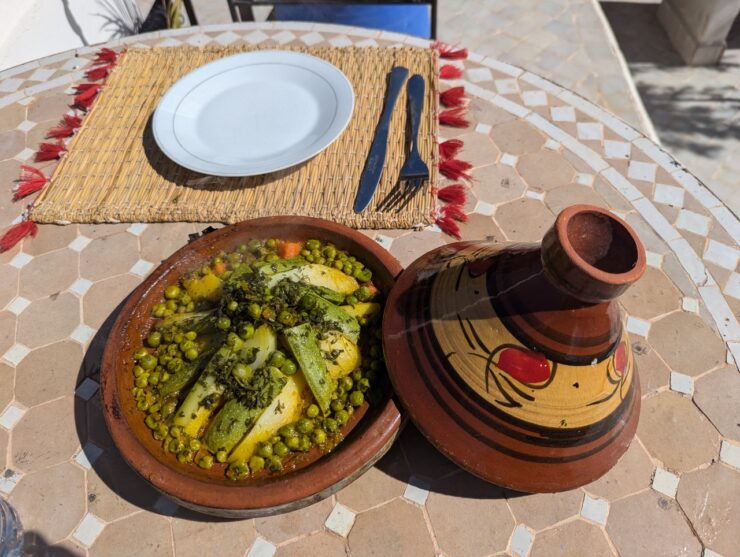
Not only did we taste exquisite meals, but we learned so much. I ordered bissara soup many times on the rest of our trip, giving silent thanks to Mohammed, for I probably wouldn’t have ordered it without having tasted it on the tour. I learned to discern the different flavors in the tagines that I tasted.
My photo album is full of photos of foods I liked, so I could remember the ingredients and create my own versions at home. Many Moroccan recipes are available online. However, knowing just a little about the dishes we tasted on the Tangier tour and prepared in the Marrakech class helped me evaluate what I’m looking for.
I even learned to make the khobz bread, since there’s nothing like it in my town in California. Mine were a little misshapen and not as light, but they still bring back wonderful memories of aromatic tagines and sop up the savory liquid just the same.
Through these meals, I carried Morocco home with me. Each flavor was a reminder that food is one of the most powerful ways to connect with a place and its people.
If You Go
Morocco entices the visitor with its mix of ancient medinas, bustling souks, and mouthwatering cuisine. Tangier offers a gateway to both Europe and Africa, while Marrakech brims with history, gardens, and colorful markets. Food tours and cooking classes are a wonderful way to experience the authentic flavors of the country.
The old quarters (medinas) are maze-like but walkable; be prepared for narrow alleys, uneven pavement, and a lot of people. Comfortable shoes are essential. Taxis are inexpensive for short hops, while trains and buses connect major cities. First-class compartments on trains are clean, air-conditioned, and efficient. They connect most of the major cities between Tangier and Marrakech along the coastal route.
Many riads — traditional Moroccan houses with open courtyards — have been converted into charming lodgings that feel worlds apart from standard hotels. Staying in one place enhances the cultural experience.
Other Things to Consider
Currency is the Moroccan dirham (MAD). While credit cards are accepted in larger establishments, cash is often preferred in markets and small eateries. ATMs are plentiful in the cities.
Arabic is spoken in Morocco, but English and French are widely spoken in the cities and in tourist establishments. There’s some Spanish, especially in the northern region, and you’ll see the influence in the food as well.
Dress modestly, especially in rural areas and religious sites. Morocco is not as strict as other Muslim countries, but to be respectful, cover your shoulders and knees.
The CDC recommends that travelers avoid drinking tap water, even in cities, and stick to bottled or filtered water instead. Wash or peel fruits. Eat freshly cooked foods. Be cautious with raw salads or street food unless it looks freshly prepared and piping hot.
Spring (March–May) and fall (September–November) are the best times to visit, with warm but manageable temperatures. Summers can be intensely hot, especially in inland areas and Marrakech. Winters are mild in coastal areas but chilly in the mountains and desert at night.
For More Information
Visit Morocco (Moroccan National Tourist Office)
You’ll find several articles on Morocco at Inga’s Adventures.com. They cover everything from taking the ferry from Spain, the train through Morocco, a tour to the Sahara, and a visit to the High Atlas Mountains.

